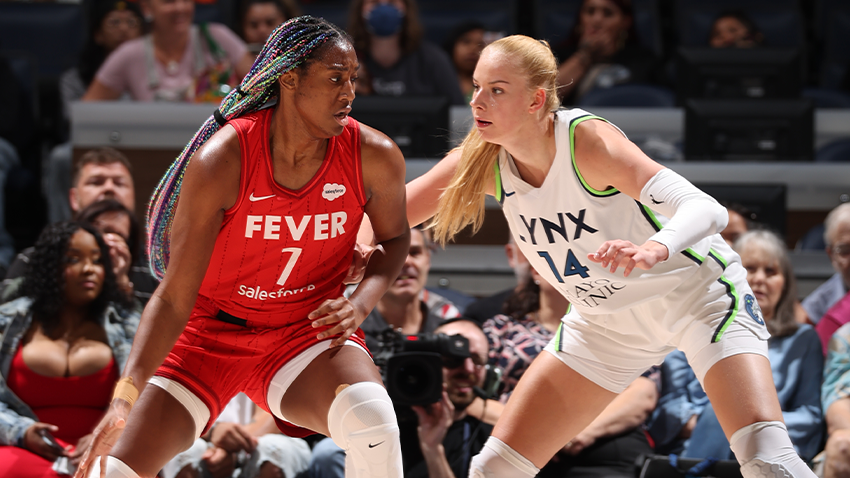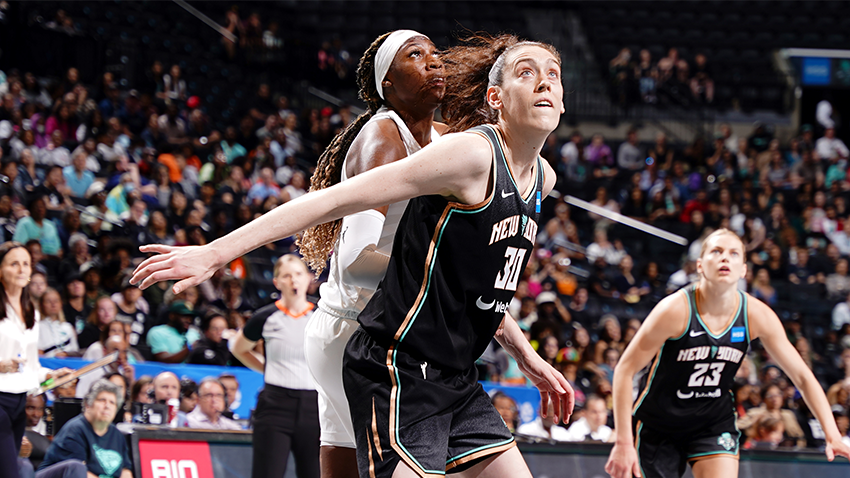Bullies On The Block: How the Aces Succeed Down Low

When discussing the dominance of the Las Vegas Aces, it’s hard not to start with their offense. Currently boasting a 114.7 offensive rating – meaning they’re scoring nearly 115 points for every 100 possessions – they’re on pace to smash the 2019 Washington Mystics’ mark (112.9) for the best offense in league history.
A’ja Wilson (19.7), Jackie Young (19.1), and Kelsey Plum (19.1) all rank in the top ten in scoring. Chelsea Gray is on pace to join the 50/40/90 club – shooting over 50 percent (51.8) from the field, 40 percent (45.5) from three, and 90 percent (95.2) from the free throw line. It took time for Candace Parker to find her rhythm, but she’s been insanely efficient (56.3% from the field, 44% from three) over her last ten games.
Amidst the Aces’ modern, pace-and-space approach, what’s gone under the radar is how much better they’ve been at going old school.
They didn’t press the “post-up” button often last season, nor did they have much success. Per Synergy, the Aces ranked last in post-up frequency (5.7% of possessions, passes included) and 11th in points per possession (0.898 PPP).
This year, they’ve nearly doubled their frequency (10.2%, 8th) while improving to second in efficiency (1.138 PPP), only trailing the Brittney Griner-led Phoenix Mercury (1.167 PPP).
While the Aces didn’t enter the year with post-improvement as a specific goal, head coach Becky Hammon recently discussed some key differences from last year to this one.
“We’ve played a little less small-ball than we have in the past. We’ve gone a bit bigger than we did last year, with Candace being in there,” says Hammon.
“We’ve also been able to post up our guards. I think that goes into it, too, with Alysha [Clark] and Chelsea coming in there sometimes, so it isn’t just A’ja. Obviously, A’ja is [still] the bulk of it.”
The conversation must start with the 2x MVP. Not only has Wilson been the best post-up player in the league (1.202 PPP), the Aces double the pain by having their perimeter players – most notably, Plum – set a mix of cross and back screens to pry her open. Teams naturally don’t want to switch smaller players onto Wilson, leading to deeper catches – and easier buckets.
Parker’s impact has been felt two-fold. She can get busy on the block herself (1.167 PPP), sprinkling in post fades and jump hooks or taking advantage of aggressive defenses with her passing ability. More quietly, she’s able to bend defenses from the perimeter in a unique way.
Instead of stretching teams thin with her shooting (though she can do that on occasion), her ability to make entry passes – plus the threat of her flowing into handoffs or ball screens if teams sag off of her – pull her matchup out of the paint, opening more space inside.
The real fun begins when the Aces flip the script.
Gray, Clark, and occasionally Young are comfortable bullying smaller defenders for buckets, shooting fouls, or both. The Aces can invert the floor, using their bigs as facilitators or spacers so their perimeter players can go to work. Frankly, most defenses aren’t equipped to deal with that.
The Aces love flowing out of the HORNS alignment – the tell is when both corners are filled, and a player is stationed at each elbow.
Usually, when teams (like the Dallas Wings or Connecticut Sun) flow out of HORNS, their perimeter players are in the corners, while their bigs are at the elbows. However, the Aces like to distort spacing by stationing a guard at one or both elbows before playing out of things from there. Here’s a quick example:
Of course, the Aces don’t have to be that meticulous for their guards. Gray can get quick dump-downs or dribble into post-ups whenever she feels like asserting herself. So far, she’s converted an absurd 70% of her post-up looks this season.
Clark has drained over 58% of her shots via post-up. She operates the most like a big, showcasing an ability to seal off her matchup early in transition or flash to the middle of the floor as a secondary option.
Young hasn’t been as efficient (44.4% FG) but wins in the quick-hitting variety. Instead of jogging to the block and setting up shop, she’s more likely to slice into the paint from the perimeter for bang-bang buckets.
The Aces already exhaust teams in transition, dice them up in pick-and-roll, and embarrass defenders when isolating. You can add elite post-play to the list this year, adding another layer to the league’s most potent offense.
WNBA reporter Nekias Duncan writes columns on WNBA.com throughout the season and can be reached on Twitter at @NekiasNBA. The views on this page do not necessarily reflect the views of the WNBA or its clubs.






,xPosition=.5,yPosition=.5)
,xPosition=.5,yPosition=.5)
,xPosition=.5,yPosition=.5)
,xPosition=.5,yPosition=.5)